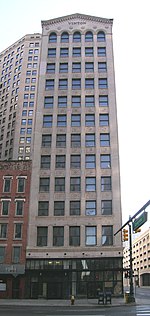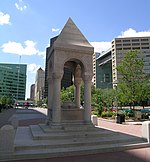Meridian Health Plan Headquarters
Meridian Health Plan Headquarters was a planned highrise in the Campus Martius district of downtown Detroit. The skyscraper would have had 16 stories with office space, ground level retail outlets, a state-of-the-art plaza, and a 9-story, 1,000 space parking deck. Detroit-based Meridian Health Plan would have been the sole office tenant in the 16-story building on the block bounded by Monroe, Bates and Farmer streets by Campus Martius Park. Meridian planned to occupy to 300,000 square feet of space in the $111 million development. Designs for the Class A building included first-floor retail space and a nine-story, 1,000-space parking deck. The brownfield incentives would be for site preparation and infrastructure improvements at the 1.96-acre site, a 230-space surface parking lot. Meridian, which has about 620 employees in two downtown offices in One Kennedy Square, 777 Woodward Ave., and the Dan Gilbert-owned 1001 Woodward building, would move into its new headquarters in early 2017, according to Sean Cotton, the company's general counsel. By that time, the company expects to have 1,050 employees in Detroit. Meridian initiated the new building project and hired Livonia-based Schostak Bros. as the developer.
Excerpt from the Wikipedia article Meridian Health Plan Headquarters (License: CC BY-SA 3.0, Authors).Meridian Health Plan Headquarters
Woodward Avenue, Detroit
Geographical coordinates (GPS) Address Nearby Places Show on map
Geographical coordinates (GPS)
| Latitude | Longitude |
|---|---|
| N 42.33 ° | E -83.045 ° |
Address
Ally Detroit Center
Woodward Avenue 500
48226 Detroit
Michigan, United States
Open on Google Maps










